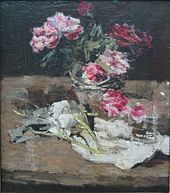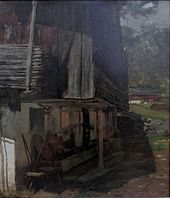Carl Schuch

Carl (Charles) Eduard Schuch (born September 30, 1846 in Vienna ; † September 13, 1903 there ), born in the Austrian Empire , more of a European in terms of self- image , is a painter at the transition to Viennese Modernism . His oeuvre can best be compared to that of Paul Cézanne .
Life
Carl Schuch came from a wealthy family; He did not have to pursue gainful employment throughout his life. But his life was marked by tragedy, overshadowed by illness and death since early youth. The loss of his parents (presumably as a result of tuberculosis) was followed by the death of his only sister Pauline († 1869): Her death drove the adolescent on a journey through Europe, which he only stopped when the venereal disease began to overwhelm him , which his Viennese had Doctors had diagnosed it as early as November 1880. “Homecoming! When I return home, you ask! ” Schuch once wrote to his childhood friend Julius Radich. “I don't want to live in Vienna because I can't work there. As I drive past I will perhaps get there - I think I can only stay there forever if I feel destroyed and sick to die - then every bear looks for its den, every bird its nest, every dog its hut - around curled up to die quietly and shyly. "
Financially independent and restlessly wandering around, Schuch's biography cannot be definitively reconstructed for the time being. Although he seems to have started a regular course of studies at the art academy in Vienna on October 6, 1865, he soon broke it off to travel the country as a private student with the landscape painter Ludwig Halauska, who was also valued by the imperial family . After the death of his sister Pauline, Schuch went to Unterach am Attersee , “in order to bring Halauska to study with Halauska in the summer - then I'll go away for a long, very long time.” At the beginning of December 1869, Schuch made the acquaintance of the in Venice painting architecture student Albert Lang , with whom he toured Italy in the following 12 months (in the footsteps of Seumes and others); the political turmoil of these days may have suggested an early departure, but at the same time delayed it. From Sicily, Schuch and Lang reached Florence via Naples and Rome, in whose surroundings (Campagna, Olevano) they were kept for a long time. There they parted ways for a short time: Lang went to Munich; Schuch via Venice to Vienna, but soon went back to see Lang in Munich, who introduced him to his corps brother Wilhelm Trübner . In the spring of 1871 the trio took up residence and atelier in nearby Bernried , and Schuch soon set out on an “inspection tour” to the Ammersee and brought Wilhelm Leibl with him from there .
The contact with Wilhelm Leibl 'and his circle' is generally considered to be the event that shaped Carl Schuch's further career, especially since Wilhelm Trübner blew the same horn in an autobiographical note. The Schuch portraits by Rudolf Hirth du Frênes , Wilhelm Trübner and Leibl did the rest . For some, this was and is evidence enough for a clique conspired to pure painting. Doubts about this version are of course more than appropriate, because Schuch's itinerary is sketchy. Schuch was in Paris at the beginning of his career, there is sufficient evidence - but when? One thing is certain: In March 1872 Schuch was in Munich, then in Vienna and in nearby Purkersdorf. He had made an appointment with Trübner in Venice that autumn; The two traveled to Rome via Florence to spend the winter in Rome. While Trübner was returning home, Schuch went to Olevano Romano at short notice in May 1873 . Alerted by Edmund Kanoldt that the Serpentara , the oak grove that was sacred to the German-Romans, was to be cut down, Schuch took over a quarter of the cost of the purchase in favor of the German emperor and empire.
In the summer at the Hintersee in Ramsau near Berchtesgaden , Schuch made the acquaintance of Karl Hagemeister , his future biographer. Together they visited Vienna and the world exhibition there in autumn , only to rush to Brussels via Dresden for the next winter. Schuch and Hagemeister spent Christmas 1873 in Amsterdam; a second stay in Amsterdam - now with Trübner, who only arrived in Brussels after the New Year - followed in March 1874. Then there was probably another “inspection tour” that took Schuch and Trübner to Herrenchiemsee via Harz, Rügen and the Bavarian Forest. In October Trübner had to come to Karlsruhe as a one-year-old volunteer and agreed with Schuch to winter 1875/1876 in Munich; what Schuch did in these twelve months only seems so clear when he apparently returned from Olevano (!) in autumn 1875 and in spring 1876 went with Trübner first to Weßling , then again to Bernried on Lake Starnberg .

Then Schuch's wandering life came to an end insofar as he took permanent quarters for the winter months, from which he operated for the rest of the year. From 1876 to 1882 Schuch was therefore based in Venice. On the other hand, he continued to spend the summers here and there: 1877 at the Pragser Wildsee in the Pustertal, 1878 in Ferch am Schwielowsee , 1879 on a wandering between the Fassatal and Laibach, 1880 in Kähnsdorf on the Großer Seddiner See , 1881 again in Ferch. In the spring of 1882, Schuch closed his Venetian studio and spent the summer (and the following) on the Hintersee. But it was clear that he would spend the winter in Paris in the future . From 1882 to 1894 he stayed in Paris. During this time he dealt extensively with the genre of still life . It was shaped by the work of Gustave Courbet . A number of apple still lifes were created. Among other things, the picture on the left from the Lower Saxony State Museum, Hanover. It was only after the annual salon was opened and studied in detail that he set out for the summer campaign: 1884 and 1885 in Scheveningen, and since then in La Chaux-de-Fonds near the Saut du Doubs . Louise Lami, his future wife, noted that she spent seven summers there with Carl Schuch; elsewhere she named the period 1888 to 1893.
In 1893 Schuch's condition resulted in a series of spa stays. In 1894 he moved to Vienna in the spring, married Louise Lami there in the autumn and wrote his will. All other cures did not help much. At the end of February 1897 he was first transferred to the private sanatorium for the mentally ill of Dr. Wilhelm Svetlin , released in June, but final induction followed in 1898. Carl Schuch suffered a few years there. He died on September 13, 1903, just under 57 years old. The death inspection protocol of the City of Vienna noted “paralytic nonsense” as the cause of death.
Schuch was buried in an honorary grave in the Vienna Central Cemetery (Group 41 F, Row G1, No. 11).
power
Carl Schuch is one of the most important Austrian painters of realism, whose work points to the modern age. He primarily painted still lifes, but also landscapes and portraits. In terms of style, he combines features of Viennese taste culture with Gustave Courbet and Wilhelm Leibl .
Works
- Landscape with bridge ruins, Lower Saxony State Museum, Hanover , cat.-no. 107, 1870
- Horse and mule (Wuppertal, Von der Heydt-Museum , inv. No. 0068), around 1875, oil on canvas, 49.5 × 75 cm
- Self-portrait (Vienna, Belvedere , inv. No. 1360), around 1875–1876, oil on canvas, 56 × 46 cm
- Still life with apples, wine glass and pewter jug (Munich, Neue Pinakothek , inv. No. 8563), around 1876, oil on canvas, 69.2 × 92 cm
- Large kitchen still life (Vienna, Belvedere, Inv. No. 1095), 1879, oil on canvas, 160 × 183 cm
- At Seddiner See near Kähnsdorf ( Greifswald , Pommersches Landesmuseum ), probably 1880, oil on canvas, 60.5 × 82 cm
- Still Life with Wild Duck and Hunting Bag I (Vienna, Belvedere, Inv.No. 5525), 1881, oil on canvas, 53.5 × 79 cm
- Still life with a pumpkin, peach and grapes (Vienna, Belvedere, inv.no.1358), around 1884, oil on canvas, 62 × 81 cm
- Roses, biscuit plates and orange , ( Suermondt-Ludwig-Museum , Aachen), oil on canvas, 51 × 61 cm
- Still life with rhododendron (Dresden, Gemäldegalerie )
- Forest interior near Saut du Doubs (Vienna, Belvedere, Inv.No. 1096), around 1887, oil on canvas, 150 × 200 cm
- Peonies (Munich, Neue Pinakothek, inv.no.8599), around 1890, oil on canvas, 63.3 × 56.1 cm
literature
- Constantin von Wurzbach : Schuch, Karl . In: Biographisches Lexikon des Kaiserthums Oesterreich . 32nd part. Imperial and Royal Court and State Printing Office, Vienna 1876, p. 118 ( digitized version ).
- Karl Hagemeister: Carl Schuch, his life and his works . Bruno Cassirer, Berlin 1913.
- Eberhard Ruhmer: The Leibl circle and pure painting . Rosenheimer Verlagshaus, Rosenheim 1986, ISBN 3-475-52455-4 .
- Gottfried Boehm, Roland Dorn, Franz A. Morat (eds.): Carl Schuch (1846–1903) . Exhibition Städtische Kunsthalle Mannheim. Städtische Galerie im Lenbachhaus, Munich 1986, ISBN 3-89165-029-9 .
- Christiane Schmieger: “See for yourself and find yourself” - Carl Schuch and the discussion about artistic perception in the 19th century . Dissertation. Cologne 1993.
- Brigitte Buberl (Ed.): Cézanne - Manet - Schuch: Three Paths to Autonomous Art . Hirmer, Munich 2000, ISBN 3-7774-8640-X .
- Klaus J. Schönmetzler (Ed.): Wilhelm Leibl and his painter friends . Rosenheimer Verlagshaus, Rosenheim 2001, ISBN 3-475-52780-4 .
- Angelika Burger: Schuch, Carl Eduard. In: New German Biography (NDB). Volume 23, Duncker & Humblot, Berlin 2007, ISBN 978-3-428-11204-3 , pp. 621 f. ( Digitized version ).
- Roland Dorn, Fabienne Ruppen: Carl Schuch in Venice (1876–1882) , Carl Schuch Studies, Vol. 1. Verlag JP Schneider Jr., Frankfurt am Main 2012, ISBN 978-3-9802873-0-2 .
Web links
- Website of the Carl Schuch Society
- Literature by and about Carl Schuch in the catalog of the German National Library
- Entry on Carl Schuch in the Austria Forum (in the AEIOU Austria Lexicon )
- Works by Carl Schuch at Zeno.org .
- Works by Carl Schuch in: Belvedere Digital Collections
| personal data | |
|---|---|
| SURNAME | Schuch, Carl |
| ALTERNATIVE NAMES | Schuch, Karl |
| BRIEF DESCRIPTION | Austrian painter |
| DATE OF BIRTH | September 30, 1846 |
| PLACE OF BIRTH | Vienna |
| DATE OF DEATH | September 13, 1903 |
| Place of death | Vienna |






